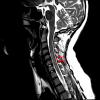Transverse Myelitis in a Healthy Adult Female Patient: A Rare Viral Etiology
- PMID: 39697943
- PMCID: PMC11655085
- DOI: 10.7759/cureus.73932
Transverse Myelitis in a Healthy Adult Female Patient: A Rare Viral Etiology
Abstract
Transverse myelitis (TM) is an uncommon but extensively documented neurological disorder marked by acute spinal cord inflammation, resulting in a spectrum of impairments including motor, sensory, and autonomic disturbances. We outline a rare case of viral-induced TM linked to COVID-19 and Coxsackie B viral infections. A 25-year-old healthy female patient presented with acute bilateral upper and lower extremity weakness, paresthesia, and urinary retention. MRI of the cervical spine revealed abnormal marrow signal intensity. Laboratory investigation highlighted the presence of SARS-CoV-2 RNA; Coxsackie B virus subtypes 1, 2, 4, 5, and 6; and positive Lyme disease IgG subtype. Lumbar puncture and systemic autoimmune cases of myelopathy were unrevealing. Treatment included high-dose steroids, plasmapheresis, Foley catheter placement, and continual physical therapy. Despite improvements, the patient did not reach baseline and was discharged for outpatient physical/occupational rehabilitation. To our knowledge, this is the only case that describes viral-induced TM associated with COVID-19, Coxsackie B, and Lyme disease simultaneously. The rarity of this case highlights the necessity for further investigation into the pathogenesis of viral-induced TM and whether viral causes contribute synergistically or independently to the onset of TM.
Keywords: acute cervical transverse myelitis; covid-19; coxsackie b virus; neuroimmunology; spinal cord inflammation.
Copyright © 2024, Namrouti et al.
Conflict of interest statement
Human subjects: Consent for treatment and open access publication was obtained or waived by all participants in this study. Conflicts of interest: In compliance with the ICMJE uniform disclosure form, all authors declare the following: Payment/services info: All authors have declared that no financial support was received from any organization for the submitted work. Financial relationships: All authors have declared that they have no financial relationships at present or within the previous three years with any organizations that might have an interest in the submitted work. Other relationships: All authors have declared that there are no other relationships or activities that could appear to have influenced the submitted work.
Figures



References
-
- Transverse myelitis--a review of the presentation, diagnosis, and initial management. West TW. https://www.discoverymedicine.com/Timothy-W-West/2013/09/29/transverse-m... Discov Med. 2013;16:167–177. - PubMed
-
- Transverse myelitis. Beh SC, Greenberg BM, Frohman T, Frohman E. https://rarediseases.org/rare-diseases/transverse-myelitis/ Neurol Clin. 2013;31:79–138. - PMC - PubMed
-
- Persistent coxsackie B encephalitis: report of a case and review of the literature. Berger JR, Chumley W, Pittman T, Given C, Nuovo G. J Neurovirol. 2006;12:511–516. - PubMed
-
- Coxsackie B3/B4-related acute flaccid myelitis. Cho SM, MacDonald S, Frontera JA. Neurocrit Care. 2017;27:259–260. - PubMed
Publication types
LinkOut - more resources
Full Text Sources
Miscellaneous
